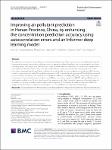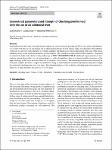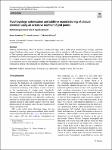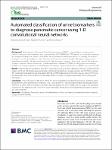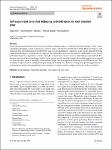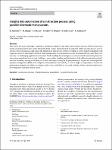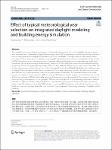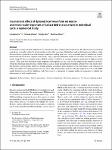Search
Author
- Osman, Ahmed I. (5)
- Daqing, Ma (3)
- Jorgensen, Ed (3)
- Li, Yan (3)
- next >
Subject
- kinh tế (26)
- Economics (12)
- programming (10)
- XRD (10)
- next >
Date issued
- 2020 - 2025 (2128)
- 2010 - 2019 (129)
- 2000 - 2009 (9)
- 1999 - 1999 (1)
Has File(s)
Search Results
Air pollution is an important issue affecting sustainable development in China, and accurate air quality prediction has become an important means of air pollution control. At present, traditional methods, such as deterministic and statistical approaches, have large prediction errors and cannot provide effective information to prevent the negative effects of air pollution. Therefore, few existing methods could obtain accurate air pollutant time series predictions. To this end, a deep learning-based air pollutant prediction method, namely, the autocorrelation error-Informer (AE-Informer) model, is proposed in this study. The model implements the AE based on the Informer model. The AE-Informer model is used to predict the hourly concentrations of multiple air pollutants, including PM10... |
In the publication, the results of an experimental analysis of joint formation by pressing of DX51D steel sheets with thickness of 1.5 (mm) with the use of a rigid punch and an additional deformable rivet of various shapes were presented. The influence of the use of a steel rivet with a diameter d = 5 (mm), similar to the dimensions of the forming punch in the case of the classic clinching variety on the interlock parameters was investigated. The used die was with a four movable segments—dedicated to connections made in the clinch-riveting technology by TOX® PRESSOTECHNIK. In additional, experimental tests were made for joining sheets with a rivet of various shapes, i.e. with a through hole. Joints were formed and the correctness of the upper blockage in the lower sheet was observed... |
Additive manufacturing (AM) can fabricate complicated shapes and is useful when manufacturing topology optimized shapes. Fluid parts often consists of three dimensional curves that are suitable for AM fabrication. However, the application of fluid topology optimization and AM has not been investigated yet. However, modeling and solving an optimization problem have not been investigated for a real industrial fluid topology optimization problem of AM parts with tiny channels, i.e., a liquid atomizer which is equipped with an aero-engine fuel injector. In order to reduce computation time, which is an important issue in real industrial problem, the instantaneous sensitivity approximation method is used as a topology optimization method. The optimized part exhibited a reduction in pressu... |
Early diagnosis of Pancreatic Ductal Adenocarcinoma (PDAC) is the main key to surviving cancer patients. Urine proteomic biomarkers which are creatinine, LYVE1, REG1B, and TFF1 present a promising non-invasive and inexpensive diagnostic method of the PDAC. Recent utilization of both microfluidics technology and artificial intelligence techniques enables accurate detection and analysis of these biomarkers. This paper proposes a new deep-learning model to identify urine biomarkers for the automated diagnosis of pancreatic cancers. The proposed model is composed of one-dimensional convolutional neural networks (1D-CNNs) and long short-term memory (LSTM). It can categorize patients into healthy pancreas, benign hepatobiliary disease, and PDAC cases automatically. |
Most learning-based methods previously used in image dehazing employ a supervised learning strategy, which is time-consuming and requires a large-scale dataset. However, large-scale datasets are difficult to obtain. Here, we propose a self-supervised zero-shot dehazing network (SZDNet) based on dark channel prior, which uses a hazy image generated from the output dehazed image as a pseudo-label to supervise the optimization process of the network. Additionally, we use a novel multichannel quad-tree algorithm to estimate atmospheric light values, which is more accurate than previous methods. Furthermore, the sum of the cosine distance and the mean squared error between the pseudo-label and the input image is applied as a loss function to enhance the quality of the dehazed image. |
This article discusses challenges, experiences and lessons learned so far while transforming a masonry build system based mostly on manual labour into a robot automated build system. Our motivation for selection of this masonry process is to try out how robot automation could impact the architects in their design work by providing a tool to directly manipulate wall expression down to individual brick level. Such manipulation is often much too costly for manual labour today. Moreover, masonry is a challenging application to automate. Understanding the manual processes involved and transforming them into automation equivalents faces several challenges; among them handling and distribution of the different materials involved, selection of tooling, sensing for handling of variation and ... |
The complete description of outdoor luminous and thermal environment is the basis for daylight utilization design with simulation tools. Nevertheless, Typical Meteorological Year (TMY) and generation method specifically developed for the energy simulation of daylight-utilized buildings is still unavailable currently. Luminous environment parameters have not been taken into consideration in existing TMY generation methods. In this study, the feasibility of existing TMY generation process has been examined. A generic office model implementing sided window daylighting is established. |
Articulating crane (AC), a widely used crane, plays an essential role in various industrial activities. Owing to its strong nonlinearity and uncertainty, its tracking control remains challenging, particularly for precise dynamic tracking control. This paper proposes an adaptive diffeomorphism-constraint-based control (ADCBC) for a nonlinear AC to robustly achieve trajectory tracking while guaranteeing desired dynamic control performance (DDCP), considering (possibly rapid and irregular) time-variant uncertainty with unknown bounds. A user-definable hard-limiting function was used to guarantee the DDCP, including the requirement for steady-state tracking error and dynamic convergence speed. The desired trajectories and DDCP were formulated as equality and inequality servo constraints... |
The development of a planar manipulator with flexure joints and redundant actuation has been considered before, showing that the redundancy can be exploited to increase the support stiffness and to reduce static actuator loads. In this previous design the manipulator’s workspace has been defined to encompass all kinematically accessible end effector positions. In the current paper we reconsider the design philosophy. It will be shown that limiting the workspace (“less”) ultimately results in a better performance in a larger area (“more”). |
Cyclic load is widely adopted in laboratory to simulate the effect of train load on ballast bed. The effectiveness of such load equivalence is usually testified by having similar results of key concerns of ballast bed, such as deformation or stiffness, while the consistency of particle scale characteristics under two loading patterns is rarely examined, which is insufficient to well-understand and use the load simplification. In this study, a previous laboratory model test of ballast bed under cyclic load is rebuilt using 3D discrete element method (DEM), which is validated by dynamic responses monitored by high-resolution sensors. |

